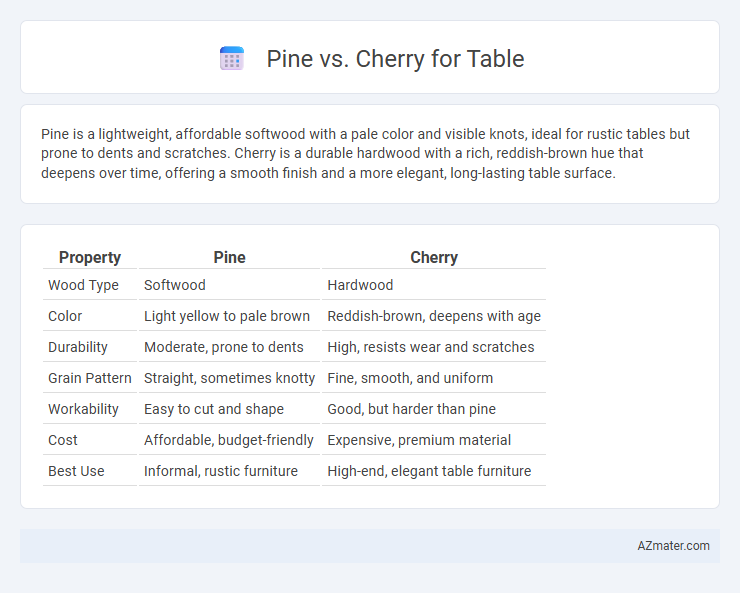Pine is a lightweight, affordable softwood with a pale color and visible knots, ideal for rustic tables but prone to dents and scratches. Cherry is a durable hardwood with a rich, reddish-brown hue that deepens over time, offering a smooth finish and a more elegant, long-lasting table surface.
Table of Comparison
| Property | Pine | Cherry |
|---|---|---|
| Wood Type | Softwood | Hardwood |
| Color | Light yellow to pale brown | Reddish-brown, deepens with age |
| Durability | Moderate, prone to dents | High, resists wear and scratches |
| Grain Pattern | Straight, sometimes knotty | Fine, smooth, and uniform |
| Workability | Easy to cut and shape | Good, but harder than pine |
| Cost | Affordable, budget-friendly | Expensive, premium material |
| Best Use | Informal, rustic furniture | High-end, elegant table furniture |
Introduction to Pine and Cherry Wood
Pine wood is a softwood known for its light color, straight grain, and affordability, making it a popular choice for rustic and casual furniture tables. Cherry wood, a hardwood, exhibits a rich reddish-brown hue with fine grain patterns that darken beautifully over time, prized for its durability and elegant appearance in high-end tables. Both woods offer distinct aesthetic and functional qualities, influencing their suitability in various table designs and styles.
Visual Appearance: Pine vs Cherry
Pine tables exhibit a light, creamy color with prominent knots and grain patterns that create a rustic, natural look, often favored for casual or country-style interiors. Cherry wood features a rich, warm reddish-brown hue that deepens over time, offering a smooth, elegant appearance with subtle, fine grain. The contrasting visual qualities make pine suitable for brighter, airy spaces, while cherry adds sophistication and warmth to formal or traditional settings.
Durability and Strength Comparison
Pine is a softer wood with moderate durability and weaker resistance to dents and scratches, making it less ideal for heavy-use tables. Cherry offers superior strength and hardness, providing better resistance to wear and lasting longer under daily use. The denser grain structure of cherry enhances durability, while pine remains more susceptible to surface damage over time.
Cost and Affordability Factors
Pine is generally more affordable than cherry, making it a popular choice for budget-conscious buyers looking for a cost-effective table option. Cherry wood is pricier due to its durability, rich color, and fine grain, which adds long-term value and aesthetic appeal to high-end furniture. Choosing between pine and cherry depends on balancing initial cost constraints with durability and desired finish quality for the table.
Workability for Furniture Making
Pine wood offers excellent workability due to its softness and straight grain, making it easy to cut, shape, and sand, which is ideal for crafting intricate furniture details. Cherry wood, while harder than pine, provides smooth machining and finishes beautifully, developing a rich patina over time but requiring sharper tools and more skill to work efficiently. Both woods suit furniture making, yet pine is preferred for beginner-friendly projects, while cherry is favored for durable, high-end pieces.
Maintenance and Care Considerations
Pine tables require frequent sealing and are prone to dents and scratches due to their softer wood grain, demanding regular maintenance to preserve appearance. Cherry wood tables develop a rich patina over time but need protection from direct sunlight to prevent uneven fading and require occasional polishing to maintain their luster. Both woods benefit from gentle cleaning with a damp cloth and avoiding harsh chemicals to extend their longevity.
Sustainability and Environmental Impact
Pine tables offer a sustainable choice due to their rapid growth and widespread availability, resulting in lower environmental impact compared to slower-growing hardwoods. Cherry wood, while prized for its rich color and durability, grows more slowly, making it less renewable and potentially contributing to deforestation if not sourced responsibly. Choosing FSC-certified pine or cherry ensures responsible forest management, minimizing ecological damage and promoting long-term sustainability in furniture production.
Table Longevity: Pine vs Cherry
Cherry wood offers superior table longevity compared to pine due to its dense grain structure and natural resistance to wear and dents. Pine tables tend to show scratches and dents more easily because of their softer texture, resulting in a shorter lifespan under frequent use. Properly finished cherry tables can maintain their appearance and structural integrity for decades, making them a durable investment for long-term use.
Best Applications for Each Wood Type
Pine is ideal for rustic or farmhouse-style tables due to its softness, affordability, and ease of staining, making it perfect for casual dining or craft tables that benefit from a lightweight, workable material. Cherry wood, prized for its rich color and durability, suits formal dining tables, executive desks, or heirloom furniture where a smooth finish and long-lasting strength are crucial. Pine's high resin content and vulnerability to dents contrast with cherry's dense grain and resistance to wear, guiding choices based on functional needs and aesthetic preferences.
Choosing the Right Wood for Your Table
Pine and cherry both offer distinct benefits for table construction, with pine being a budget-friendly, lightweight softwood ideal for rustic or casual styles, while cherry boasts a rich, warm tone and exceptional durability, making it perfect for heirloom-quality furniture. Pine's softer grain makes it prone to dents and scratches, whereas cherry develops a beautiful patina over time, enhancing its aesthetic appeal. When choosing the right wood for your table, consider the desired durability, budget, and visual character to ensure the wood aligns with your long-term use and design preferences.

Infographic: Pine vs Cherry for Table
 azmater.com
azmater.com